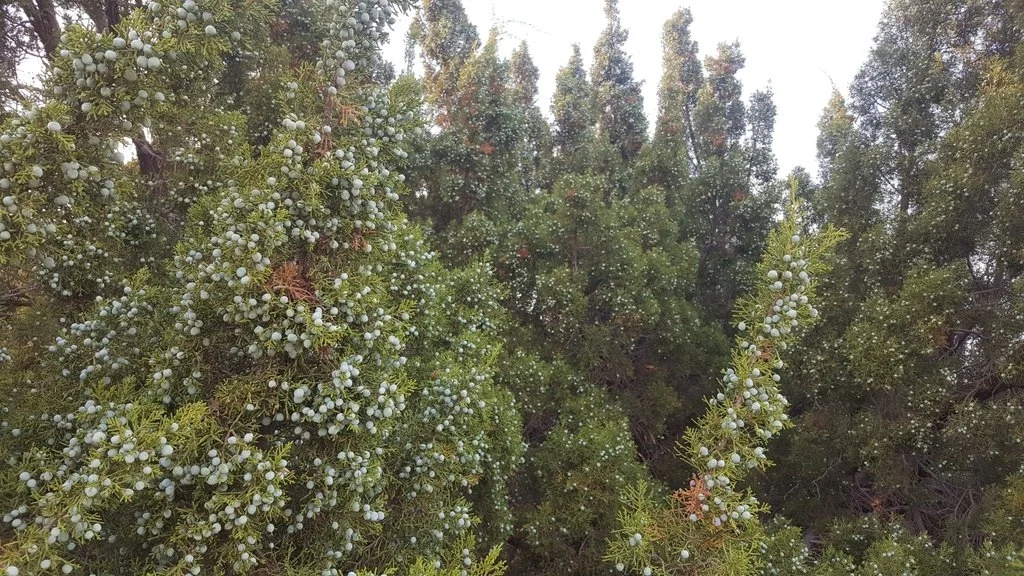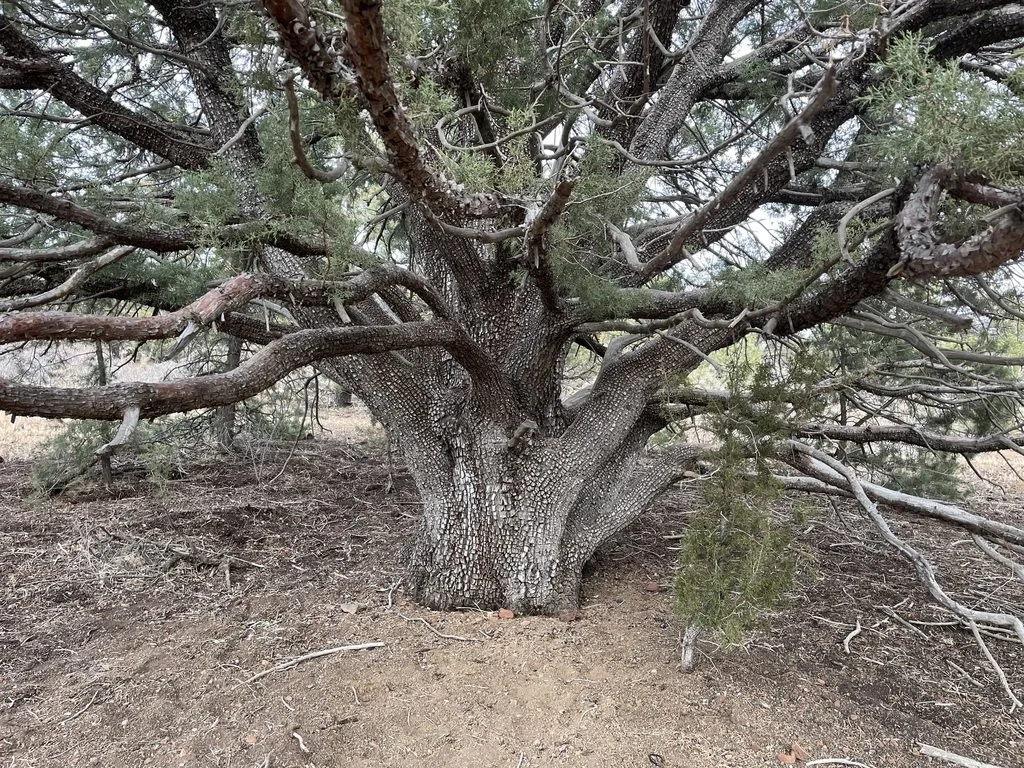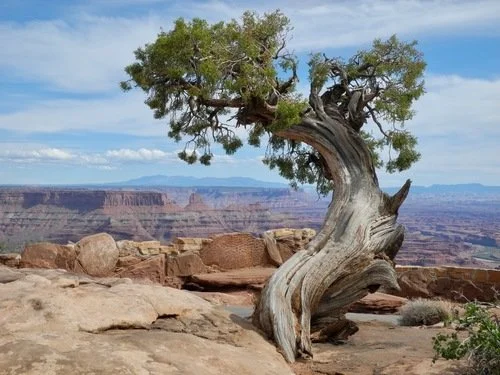The Genus Juniperus
Junipers
Family: Cupressaceae
There are 72 species of Junipers widely distributed throughout the Northern Hemisphere as far south as tropical Africa, including the Arctic, parts of Asia, and Central America. They are evergreen with needle-like and/or scale-like leaves. They can be either monoecious (both sexes in one plant) or dioecious (separate sexes on separate plants). The female seed cones are very distinctive, with fleshy, fruit-like coalescing scales which fuse together to form a berrylike structure (galbulus), with one to 12 hard-shelled seeds. In some species, these "berries" are red-brown or orange, but in most, they are blue; they are often aromatic and can be used as a spice. The seed maturation time varies between species from 6 to 18 months after pollination. The male cones are similar to the other Cupressaceae, with 6 to 20 scales.
Juniperus is the original Latin name for juniper trees.
Junipers are tough plants, but our native species could use some afternoon shade in the summer in the low desert. Always plant them in well-drained soil. Once established they usually require moderate watering. Most junipers are very cold hardy, to well below 0°F, most being able to tolerate temps as cold as -30°F.
Junipers are gymnosperms, which means they have seeds, but no flowers or fruits. Depending on the species, the seeds they produce take 1–3 years to develop. The impermeable coat of the seed keeps water from getting in and protects the embryo when dispersed. It can also result in a long dormancy that is usually broken by physically damaging the seed coat. Dispersal can occur from being swallowed whole by frugivores and mammals. The resistance of the seed coat allows it to be passed down through the digestive system without being destroyed along the way. These seeds last a long time, as they can be dispersed long distances over the course of a few years.
Junipers are important plants ecologically. Where they occur, especially in the arid southwestern United States and northern Mexico, they are important habitat plants. They are larval hosts for the Siva Juniper Hairstreak (Callophrys gryneus ssp. siva), Doll's Sphinx (Sphinx dollii), the lappet moth Gloveria arizonensis, the noctuid moth Lithophane subtilis, and other moths including many geometer moths. Many birds use the fruits of Junipers, or the fruits of the mistletoe that grows on them, the Juniper Mistetoe (Phoradendron juniperinum) and the Great Purple Hairstreak (Atlides halesus) uses mistletoe as a larval host. Junipers are host to many galls including the Juniper Tip Midge (Oligotrophus betheli).
Juniper fruits are used as a spice around the world. The fruits are used in a multitude of liquors, and are the primary source of gin and jenever. Juniper berry sauce is often a popular flavoring choice for quail, pheasant, veal, rabbit, venison, and other game dishes.
The young twigs of Juniper are used to spice foods as well, and is also used as a tea (both for pleasure and medicinally).
Most species of juniper are flexible and have a high compression strength-to-weight ratio. This has made the wood a traditional choice for the construction of hunting bows among some of the Native American cultures in the Great Basin region. These bow staves are typically backed with sinew to provide tension strength that the wood may lack. The wood also resists rotting and as a consequence is a favorite for building materials such as fence posts.
Juniper essential oil is an important scent that is distilled from the berries.
Redberry Juniper
Juniperus arizonica
Almost unheard of in the trade. A large shrub, reaching up to 15’ tall. The berries are bluish at first but maturing blue-brown to reddish-brown the second year and these reddish berries make this juniper one of the more easy to identify.
Found on dry, well-drained soils in full sun, from 4,000-6,500 ft in Arizona, SW New Mexico, and down into northern Mexico. Distinguished by the soft, fleshy, sweet cones which are pink to yellow-orange to dark red (as opposed to red-blue and brown-blue in J. monosperma). Formerly considered a variety of Juniperus coahuilensis.
Photo by Sam Hough, iNaturalist
Juniperus arizonica on SEINET
California Juniper
Juniperus californica
Shrub up to 30’ tall but rarely tall in Arizona where it is found. Plants are dioecious though some individuals are monoecious. The California juniper is closely related to the Utah juniper (J. osteosperma) from further east, which shares stout shoots and relatively large cones, but differs in that Utah juniper is largely monoecious.
Found on dry, rocky slopes and flats; 2400-5500’ in Arizona, California, Nevada, and Mexico in Baja California. In Arizona plants are mostly in the northwestern part of the state.
Photo by amthinkia on iNaturalist
Juniperus californica on SEINET
Alligator Juniper
Juniperus deppeana
Evergreen, large shrub or small tree, 30-45’ high and wide. This species is distinctive with its checkered bark on the trunk lending its common name “alligator juniper”. The species is largely dioecious, producing cones of only one sex on each tree, but occasional trees are monoecious.
Found on dry, rocky slopes from 4,500-10,000 ft. in Arizona, New Mexico, south through the Sierrra Madre Occidental, and the southern end of the Sierra Madre Orientale.
Photo by lejones417 on iNaturalist
Juniperus deppeana on SEINET
One-Seed Juniper
Juniperus monosperma
Evergreen conifer tree (or large shrub), 10-20’ tall and wide. Grow in full to part sun, low water, hardy to -30°F. It is usually dioecious, with male and female cones on separate plants, but occasional monoecious plants can be found. The berries have only one seed, easily distinguishing this species from the other Junipers if the specimen is fruiting.
Found on dry hills, plains, and plateaus, often mixed with ponderosa and pinyon pines and other Juniper species, from 3,000-7,000 ft in Arizona, Colorado, New Mexico, and Texas, right to the border. Though a few specimens were known in Sonora in the past, this species now seems to be absent from Mexico.
Photo by Andrew Tree, iNaturalist
Junierpus monosperma on SEINET
Utah Juniper
Juniperus osteosperma
Large shrub or tree, reaching up to 40’ though seen much smaller in our region. Plants are largely monoecious with both sexes on the same plant, but around 10% of plants are dioecious, producing cones of only one sex. Characteristics that differentiate it are a harder, mealier seed cone (berry) and a growth form that is more often single-trunked. A very slow-growing species known to live to at least 650 years, J. osteosperma has highly decay-resistant wood.
Rocky slopes, canyons, streambanks, in pure stands or mixed with ponderosa or pinyon pine and other juniper species, 2600-9000 ft. in the interior western United States as far north as Montana, south almost to the border in Arizona, east to Texas, west to the coastal states, but not on the coast.
Photo by Michael J. Papay, iNaturalist
Juniperus osteosperma on SEINET
Rocky Mountain Juniper
Juniperus scopulorum
Large shrub or small tree to about 65’ tall. Grow in full to part sun, low water, hardy probably to -30°F or lower. Distinctive in cooler canyon bottom sites with its drooping branch tips and bluish-green color. Plants are usually dioecious, producing cones of only one sex on each tree, but is occasionally monoecious.
Found in canyon bottoms, often on dry, and rocky slopes from 3500-9000’ throughout the western United States from southwestern Canada to northern Mexico.
Photo by Max Licher, SEINET
Juniperus scopulorum on iNaturalist







